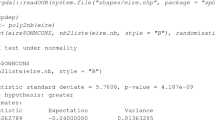Abstract
Fractal properties of the Pareto probability distribution are used to generalize “the 20/80 law.” The 20/80 law is a heuristic law that has evolved over the years into the following rule of thumb for many populations: 20 percent of the population accounts for 80 percent of the total value. The generalp100/q100 law in probabilistic form is defined withq as a function ofp, wherep is the population proportion andq is the proportion of total value. Using the Pareto distribution, thep100/q100 law in fractal form is derived with the parameterq being a fractal, whereq unexpectedly possesses the scale invariance property. The 20/80 law is a special case of thep100/q100 law in fractal form.
Thep100/q100 law in fractal form is applied to petroleum fieldsize data to obtainp andq such thatp100% of the oil fields greater than any specified scale or size in a geologic play account forq100% of the total oil of the fields. The theoretical percentages of total resources of oil using the fractalq are extremely close to the empirical percentages from the data using the statisticq. Also, the empirical scale invariance property of the statisticq for the petroleum fieldsize data is in excellent agreement with the theoretical scale invariance property of the fractalq.
Similar content being viewed by others
References
Douglass, M.E., and Douglass, D.N., 1993, Manage your time your work yourself: New York, AMACOM, 194 p.
Drew, L.J., 1990, Oil and gas forecasting-Reflections of a petroleum geologist: New York, Oxford University Press, International Association for Mathematical Geology, Studies in Mathematical Geology, No. 2, 252 p.
Johnson, N.L., and Kotz, S., 1970, Continuous univariate distributions-1: New York, John Wiley & Sons, Inc. 300 p.
Mandelbrot, B.B., 1966, Forecasts of future prices, unbiased markets, and ‘martingale’ models. Journal of Business, University of Chicago, v. 39, p. 242–255. [Important errata in a subsequent issue of the same journal.]
Mandelbrot, B.B., 1982, The fractal geometry of nature: San Francisco, W.H. Freeman and Co., 460 p.
NRG Associates, Inc., 1992, The significant oil and gas fields of the United States [through December 31, 1990]: Available from Nehring Associates, Inc., P.O. Box 1655, Colorado Springs, Colorado 80901.
Pareto, V., 1897, Cours d'Economie Politique: Lausanne and Paris, Rouge and Cie.
Turla, P.A., and Hawkins, K.L., 1983, Time management made easy: New York, E.P. Dutton, 206 p.
Author information
Authors and Affiliations
Rights and permissions
About this article
Cite this article
Crovelli, R.A. The generalized 20/80 law using probabilistic fractals applied to petroleum field size. Nat Resour Res 4, 233–241 (1995). https://doi.org/10.1007/BF02257575
Received:
Revised:
Accepted:
Issue Date:
DOI: https://doi.org/10.1007/BF02257575




